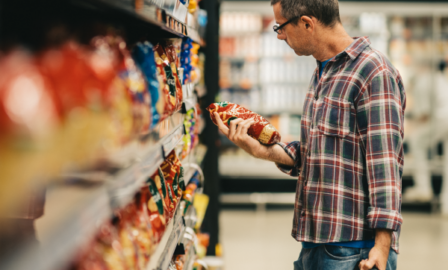Deploying Direct-to-Consumer Strategies in Food and Beverage
To read our companion piece on direct-to-consumer strategies specific to the consumer healthcare industry, click here.
Think back to the last time you needed to pick up groceries for dinner. Did you check the local store mobile app to see what was on sale? Or were you in a pinch and decided to place an order for delivery to your doorstep? Today, 49% of U.S. consumers shop for CPG products online – a group that will continue to trend upward. Organizations across the supply chain are developing new opportunities to make the consumer’s purchasing habits quick, easy, and accessible both in-store and online. Given the significant rise of eCommerce in place of store visits, leaders must transform their business offerings to remain competitive in the ever-changing food and beverage industry.
The evolving direct-to-consumer landscape is comprised of channels including in-house capabilities, e-tailer partnerships, and Amazon relationships. While brick-and-mortar sales are still the main channel of purchasing for consumers, it’s crucial to build or integrate online platforms that truly make the consumer journey a seamless process. Consider the impact to the crucial aspects of your business, including manufacturing and logistics, product information management, product quality, and brand marketing strategies. In order to remain competitive in the market and relevant to your consumers, it’s important to ensure that brick-and-mortar offerings support digital channels and vice versa.
Considering the digital disruption in the market, how can food and beverage companies engage the digitally-focused consumer? What are the core capabilities that support high quality and transparent food and beverage product distribution?
Addressing these questions will require food and beverage companies to pursue at least one of the below options:
- Selling through Amazon,
- Selling through e-tailer partners, and/or
- Building in-house DTC capabilities
Whichever option(s) are pursued, your food and beverage business will still face obstacles and opportunities. Deciding on a direct-to-consumer strategy requires careful consideration to your business’ digital capabilities, long-term goals, and growth strategies. Below, we’ve highlighted some of the challenges and advantages for food and beverage companies with each option.
#1 – The Amazon Effect – Sell Through Amazon
Amazon has established itself in eCommerce by building and continuing to improve a leading platform and suite of capabilities. With the acquisition of Whole Foods, Amazon made clear intentions to remain dominant in the food and beverage retail space. In 2018, Amazon is estimated to capture 49.1 percent of the US online retail spend. There is no question that Amazon has established itself as the eCommerce conduit for a broad range of consumers seeking products across several industries. For CPG manufacturers seeking to remain lean with their in-house eCommerce capabilities, Amazon provides the technology, logistics access, and consumer base needed to establish DTC channels.
Take Campbell’s, for example, who in August launched v8 +Hydrate energy drinks and sold it exclusively online for their product launch. Amazon took pre-orders, while other eCommerce retailers such as Walmart.com and Peapod sold the new products for the first few months of product release. Campbell’s plans to roll out the product in traditional stores in November 2018. The company is employing a digital-first eCommerce strategy by targeting large consumer populations on Amazon first, then releasing to the broader traditional store audience.
While Amazon serves as a wide-ranging channel to sell products, there is complexity associated with SKU maintenance to remain profitable. Given the growing number of sellers on Amazon and the stringent fees associated with SKU placement, your profit margins might take a bigger cut than expected. In addition, Amazon’s branding guidelines require close attention to detail to ensure your product information is clear and compliant (i.e. white backgrounds, no promotional materials, etc.).
From a food and beverage perspective, Amazon offers consumers the ability to purchase through the Amazon Marketplace, Amazon Fresh, and Amazon Fresh Direct. Each of these options provides varying convenience factors depending on how soon the products are required. Selling through one of Amazon’s Fresh delivery services ensures your perishable products are handled properly. According to IRI, 67% of millennial consumers desire for fresh and locally sourced foods. Keeping that in mind, Fulfilment by Amazon capabilities provide cold storage and shipping capabilities ensure product quality and freshness is maintained. What’s more is Amazon’s access to 460 Whole Foods store locations across the country, which reduces the amount of time Amazon takes to ship fresh food orders.
Advantages: Guaranteed traffic, easy maintenance, shipping services
Challenges: Steep service costs and high cold storage fees, demanding compliance with processes, competition with other brands, limited ownership of brand experience, high cost of data, digital content management
Considerations: How to keep perishable products fresh and stable during shipping process that maintains their shelf-life? Are there ways to adapt packaging to ship smaller quantities of product from distribution site to consumers? Do product labels contain transparent ingredients and nutritional value?
#2 – The Online Marketplace – Sell Through E-tailers
It is no longer enough for brick-and-mortar retailers to rely on in-store sales – eCommerce is now required to remain relevant with consumers. Big-box retailers such as Walmart and Target continue to expand their eCommerce capabilities through click-and-collect methods and direct delivery services. Walmart especially stands out with their push to expand beyond online sales. They’ve increased digital capabilities and offer in-store pickup capabilities to draw customers into their stores. Brands and retailers already have long-standing relationships with Walmart, so this additional channel can be a simple way to introduce your brand to digital, especially if your supply chain logistics are already established to reach Walmart stores.
We also see brands partnering with other online retailers that have gained traction such as GoPuff, which tailors to the millennial and Gen Z market by providing foods typically found in convenience stores directly to consumers on demand. Hershey partnered with GoPuff to target their audience who has a “sudden craving” for their products similar to the impulse purchases made at the checkout.
While logistically this option seems like a viable choice, there are still challenges to consider. E-tailer websites are unable to drive the same amount of traffic that Amazon can, and big-box retailers are still finding the right balance among online and in-store sales. As a food and beverage manufacturer, there is more responsibility to manage your product information, especially if partnering with several e-tailers at once. The complexity of data management requires ensuring the right data and images are placed in the correct channels according to e-tailer guidelines.
Advantages: Trusted merchant, existing customer relationships, new way of engaging with existing consumer base
Challenges: Additional system set up (ERP, etc.), competition between brands, limited access to consumer data, product/brand information management
Considerations: Are we ensuring that product naming conventions and descriptions are clear and concise to consumers on digital platforms? Does the brand messaging stand out on the digital-shelf? Is there a way to partner with subscription-based models or meal-kit offerings to place products?
#3 – Owning the Experience – In-House Direct-to-Consumer Strategies
Modern consumer preferences are changing the traditional measures contributing to brand loyalty. Consumers are looking for a brand experience that satisfies their need for personalization, convenience, freshness, and product transparency. Investing in the set-up of a DTC channel allows companies the flexibility to own that relationship.
Mondelez tested their in-house DTC capabilities by launching the “Colorfilled” online store that allowed consumers to customize Oreo packaging for the holiday season. To support their in-house DTC efforts, Mondelez partnered with Zulily, who offered daily deals and free shipping. Here we see a combination of both in-house and e-tailer capabilities that allow Mondelez to save costs on hosting all eCommerce infrastructure themselves.
Bear Naked granola established their brand by selling at retailers like Target, Walmart, and CVS. They entered the eCommerce space by creating their own website that allows consumers to create and personalize their own granola through Chef IBM Watson and the Culinary Institute of America. Beyond choosing the ingredients, consumers can create their own story and tailor the packaging to their own designs. Bear Naked is not only catering to consumers desire for personalized products with transparent ingredients, but they are also able to reap the benefits of consumer insights through their in-house eCommerce website.
Companies who build their own DTC capabilities allow for an aggregation of historical data that can be used to recommend differentiated products and determine which consumers would be the best targets for new product launches. Maintaining ownership of your eCommerce strategy and technology requires an investment both the technology but also the talent to manage and support eCommerce strategy execution. Beyond investing in additional resources, a thorough assessment of existing technologies and supply chain processes will need to take place to ensure they merry with a new DTC channel.
Advantages: Own the brand experience, complete access to consumer data for analytics, platform to test new products & educate consumers
Challenges: Large investment in technology and resourcing, warehousing and shipping set up, additional system set up, e.g., ERP
Considerations: Is it profitable to ship small quantities to individual consumers or should you supply bulk product offerings? Do you have the capabilities to build your own eCommerce website that provides a seamless user experience? How can you leverage vast amount of consumer data to form insights that drive new product development?
The Bottom Line: One Size Can’t Fit All with DTC in Food and beverage
Successful brands understand their consumer’s motivations and values, then integrate them in their selling strategies. Oftentimes choosing a digital strategy is not as simple as choosing one option. Your strategy needs to be tailored to your business model, operations, brand, and ultimately your customers. When choosing a combination of direct-to-consumer strategies, consider the following:
- Are you managing the different retailer and e-tailer requirements for product descriptions and label information across channels to best reach consumers?
- Do you create and distribute separate SKUs for in-store shelves, wholesaler shelves, and digital shelves?
- Can your warehousing and distribution channels support cold storage and delivery for fresh food products?
- Is your organization aligned with the cross-functional effort needed to support and grow a digital eCommerce strategy?
- How do you efficiently manage each digital channel selling, marketing, and distribution strategy to optimize resources and spend?
As your food and beverage business explores DTC opportunities, keep in mind the importance of aligning your people, processes, and technology. The success of your digital strategy relies investing in digital talent training and managing your retail partnerships. Once in alignment with your organization and partners, your business will be set up for success as the digitally-focused market continues to evolve.
Coauthor and contributions by Lorraine Mackiewicz



